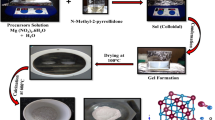Abstract
Pure and tin-doped magnetite nanoparticles (NPs) were synthesized successfully by co-precipitate method. Scanning electron microscope (SEM) and energy-dispersive X-rays (EDX) specified quantitative evidence for synthesized NPs. The pure and tin-doped magnetite NPs have average particle size of 30 nm and 200 nm, respectively. The magnetite NPs indicate well-defined magnetic behavior and doping of non-magnetic tin decrease its magnetization. The EDX graph indicated doping of Sn+2 ions, whereas XRD results were very effective in structural analysis. The rietveld refinement was helpful for determination of material’s structure. The doping of tin in magnetite structure was also specified by FTIR peak at \(\sim 546 {\mathrm{cm}}^{-1}\). The pure and tin-doped magnetite NPs showed almost same antimicrobial behavior against Staphylococcus aureus, whereas tin-doped magnetite NPs showed more antimicrobial behavior against Escherichia coli. These NPs are biocompatible and show effective antimicrobial behavior; therefore, these NPs are potent candidates for biomedical application. These NPs also showed incredible adulticidal behavior against Aedes aegypti, which have been characterized for the first time in the literature.










Similar content being viewed by others
Data availability
The authors confirm that the data supporting the findings of this study are available within the article. Raw data that support the findings of this study are available from the corresponding author, upon reasonable request.
References
F.C. Zhou, Y.H. Sun, S. Liu, J.M. Nan, Synthesis of SnFe2O4 as a novel anode material for lithium-ion batteries. Solid State Ionics 296, 163–167 (2016)
P. Guardia, A. Labarta, X. Batlle, Tuning the size, the shape, and the magnetic properties of iron oxide nanoparticles. J Phys Chem 115, 390–396 (2011)
S. Laurent et al., Magnetic iron oxide nanoparticles: synthesis, stabilization, vectorization, physicochemical characterizations and biological applications. Chem Rev 108, 2064–2110 (2008)
A. Radoń et al., Structure and magnetic properties of ultrafine superparamagnetic Sn-doped magnetite nanoparticles synthesized by glycol assisted co-precipitation method. J Phys Chem Solids 145, 109530 (2020)
R. Lamouri et al., Effect of the cations distribution on the magnetic properties of SnFe2O4: first-principles study. J Magn Magn Mater 436, 6–10 (2017)
P.L. Rathi, S. Deepa, Structural, magnetic, thermal and optical properties of Sn2+ cation doped magnetite nanoparticles. Ceram Int (2019). https://doi.org/10.1016/j.ceramint.2019.09.294
Y.W. Lu, Q.S. Zhu, F.X. Liu, Magnetic properties of tin-doped magnetite nanoparticles. Phys Lett Sect A Gen At Solid State Phys 359, 66–69 (2006)
V.C.B. Pegoretti, P.R.C. Couceiro, C.M. Gonalves, M.D.F.F. Lelis, J.D. Fabris, Preparation and characterization of tin-doped spinel ferrite. J. Alloys Compd 505, 125–129 (2010)
H. Elmoussaoui et al., New results on magnetic properties of tin-ferrite nanoparticles. J Supercond Nov Magn 25, 1995–2002 (2012)
G. Gong et al., Thickness effect on the stability of unipolar resistance switching in tin ferrite thin films. Curr Appl Phys 16, 980–984 (2016)
K.T. Lee, D.M. Liu, S.Y. Lu, SnFe2O4 Nanocrystals as highly efficient catalysts for hydrogen-peroxide sensing. Chem A Eur J 22, 10877–10883 (2016)
K.T. Lee et al., Catalase-modulated heterogeneous fenton reaction for selective cancer cell eradication: SnFe2O4 nanocrystals as an effective reagent for treating lung cancer cells. ACS Appl Mater Interfaces 9, 1273–1279 (2017)
Y. Jia et al., One-pot solvothermal synthesis of magnetic SnFe2O4 nanoparticles and their performance in the photocatalytic degradation of chlortetracycline with visible light radiation. RSC Adv 6, 76542–76550 (2016)
F.J. Berry, Ö. Helgason, K. Jónsson, S.J. Skinner, The high temperature properties of tin-doped magnetite. J Solid State Chem 122, 353–357 (1996)
K. Atacan, M. Özacar, M. Özacar, Investigation of antibacterial properties of novel papain immobilized on tannic acid modified Ag/CuFe2O4 magnetic nanoparticles. Int J Biol Macromol 109, 720–731 (2018)
J. Song et al., Highly efficient bacterial removal and disinfection by magnetic barium phosphate nanoflakes with embedded iron oxide nanoparticles. Environ Sci Nano 5, 1341–1349 (2018)
S.K. Rajabi, S. Sohrabnezhad, Fabrication and characteristic of Fe3O4 @ MOR @ CuO core-shell for investigation antibacterial properties. J Fluor Chem 206, 36–42 (2018)
K. Kombaiah et al., Okra extract-assisted green synthesis of CoFe2O4 nanoparticles and their optical, magnetic, and antimicrobial properties. Mater Chem Phys 204, 410–419 (2018)
W. Louie, L.L. Coffey, Microbial composition in larval water enhances Aedes aegypti development but reduces transmissibility of zika virus. mSphere 6, e00687-e721 (2021)
M. Sarwar, Indoor risks of pesticide uses are significantly linked to hazards of the family members. Cogent Med 3, 1155373 (2016)
Author information
Authors and Affiliations
Corresponding author
Additional information
Publisher's Note
Springer Nature remains neutral with regard to jurisdictional claims in published maps and institutional affiliations.
Rights and permissions
Springer Nature or its licensor (e.g. a society or other partner) holds exclusive rights to this article under a publishing agreement with the author(s) or other rightsholder(s); author self-archiving of the accepted manuscript version of this article is solely governed by the terms of such publishing agreement and applicable law.
About this article
Cite this article
Hassan, J.U., Shamaila, S. & Sharif, R. Antibacterial and mosquitocidal activity of magnetite nanoparticles. Appl. Phys. A 128, 1115 (2022). https://doi.org/10.1007/s00339-022-06243-z
Received:
Accepted:
Published:
DOI: https://doi.org/10.1007/s00339-022-06243-z




